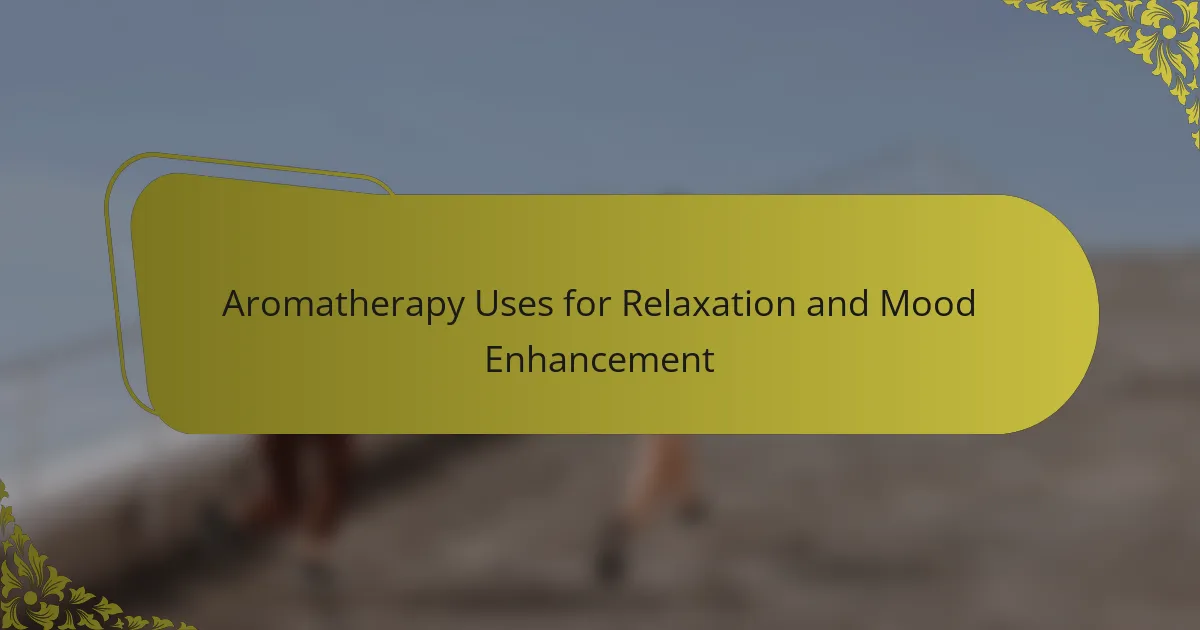Aromatherapy offers a natural way to promote relaxation and enhance mood through essential oils like lavender and chamomile. These oils can reduce stress and anxiety by lowering cortisol levels. Specific blends target emotional states, while proper practices create an ideal environment for relaxation. Integrating aromatherapy into daily routines can further boost emotional well-being.
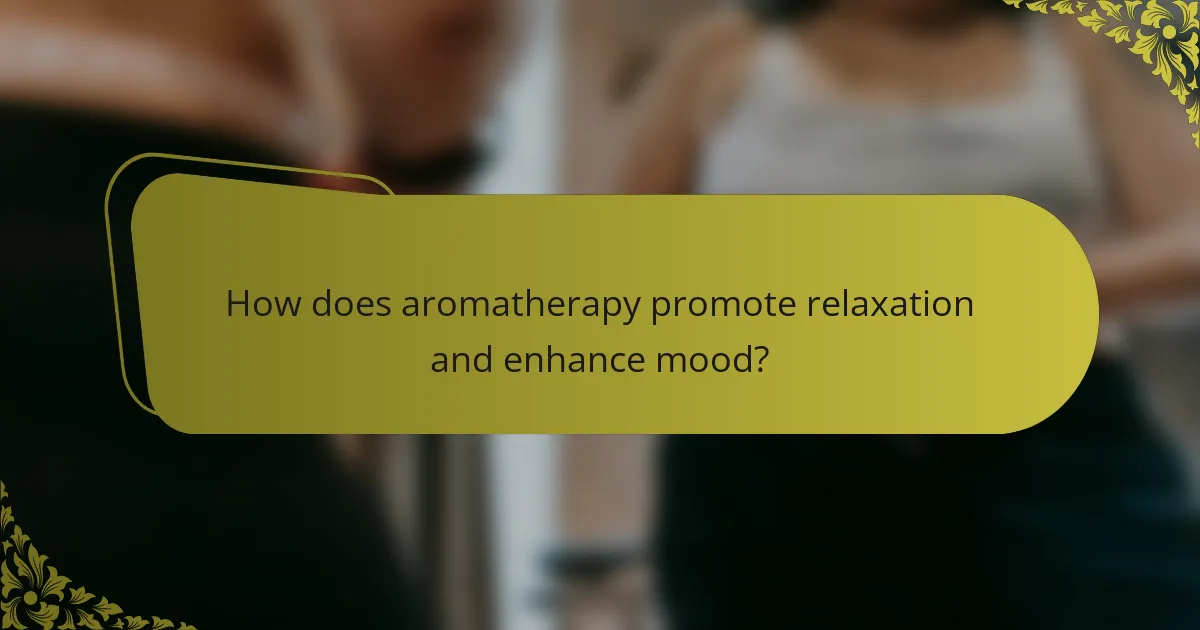
How does aromatherapy promote relaxation and enhance mood?
Aromatherapy promotes relaxation and enhances mood by utilizing essential oils that stimulate the brain’s emotional centre. These oils, such as lavender and chamomile, contain compounds that reduce stress and anxiety. Inhaling these scents can trigger positive emotional responses, leading to improved overall well-being. Research indicates that aromatherapy can lower cortisol levels, which is linked to stress reduction. Additionally, specific blends can elevate mood by increasing serotonin production, providing a natural way to enhance emotional health.
What are the key essential oils used for relaxation?
The key essential oils used for relaxation include lavender, chamomile, bergamot, ylang-ylang, and sandalwood. These oils are known for their calming properties and can enhance mood effectively.
Lavender oil is widely recognized for its ability to reduce anxiety and improve sleep quality. Chamomile oil promotes relaxation and is often used in teas for stress relief. Bergamot oil, with its citrus scent, helps alleviate feelings of sadness and anxiety. Ylang-ylang oil is known for its unique floral aroma that can lower blood pressure and enhance relaxation. Sandalwood oil provides a grounding effect, making it beneficial for meditation and stress reduction.
These essential oils can be used in various forms, such as diffusers, topical applications, or bath soaks, to create a soothing environment.
Which methods of application are most effective for mood enhancement?
Aromatherapy methods such as diffusing essential oils, topical application, and inhalation are effective for mood enhancement. Diffusing oils like lavender or citrus can create a calming environment. Topical application of oils diluted with a carrier oil can provide direct benefits through skin absorption. Inhalation of essential oils directly from the bottle or using a personal inhaler can offer immediate mood-lifting effects. Each method engages the senses, promoting relaxation and emotional balance.
How do individual responses to aromatherapy vary across cultures?
Individual responses to aromatherapy differ significantly across cultures due to varying beliefs and practices. Cultural context influences the types of essential oils used and their perceived effects on relaxation and mood enhancement. For instance, in Western cultures, lavender is commonly associated with calming effects, while in Asian cultures, sandalwood may be favoured for its grounding properties. Additionally, social norms and traditions shape how aromatherapy is integrated into daily life, affecting its overall effectiveness. Cultural attitudes towards natural remedies also play a crucial role in acceptance and application.
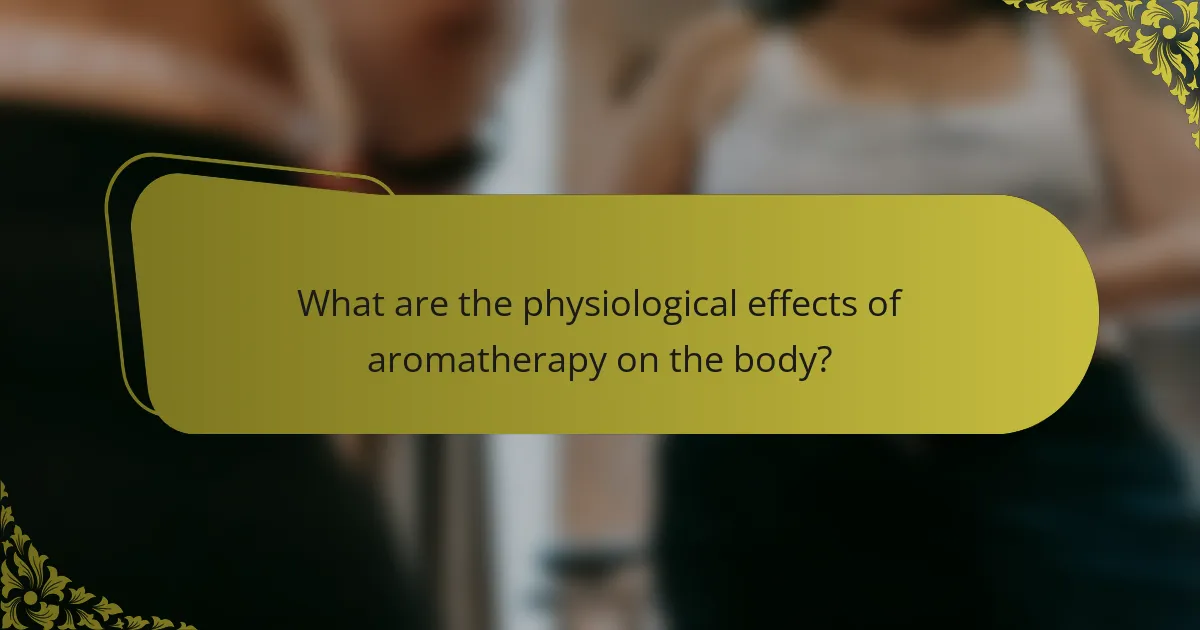
What are the physiological effects of aromatherapy on the body?
Aromatherapy positively influences the body by promoting relaxation, reducing stress, and enhancing mood. Essential oils like lavender and chamomile can lower cortisol levels, leading to a calmer state. Studies indicate that inhaling these scents can improve emotional well-being and decrease anxiety. Aromatherapy also enhances sleep quality, which is crucial for overall health.
How does aromatherapy influence the nervous system?
Aromatherapy positively influences the nervous system by promoting relaxation and reducing stress. Essential oils like lavender and chamomile can lower cortisol levels, enhancing mood. Studies show that inhaling these scents can decrease anxiety and improve sleep quality. This effect occurs due to the connection between olfactory receptors and brain regions involved in emotional regulation.
What role do scent receptors play in emotional response?
Scent receptors significantly influence emotional responses by triggering brain areas linked to memory and feelings. Aromatherapy utilizes specific scents, like lavender and citrus, to enhance relaxation and elevate mood. Research indicates that pleasant aromas can lower stress levels and promote feelings of well-being. This connection between scent and emotion underscores the importance of choosing the right essential oils for therapeutic effects.
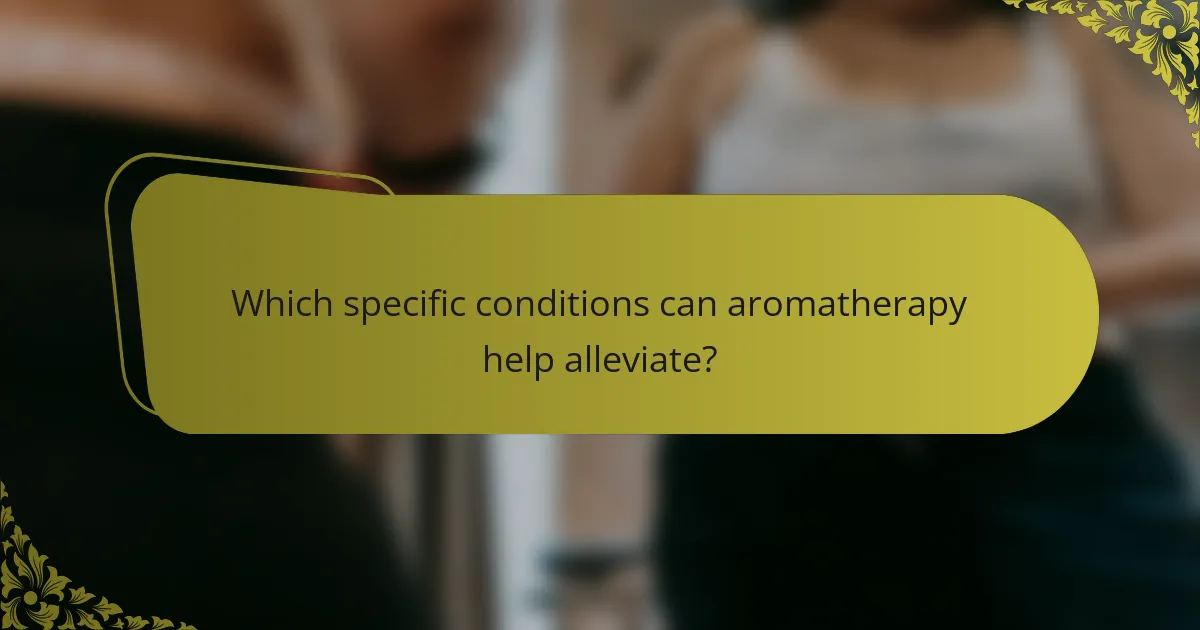
Which specific conditions can aromatherapy help alleviate?
Aromatherapy can help alleviate anxiety, stress, depression, insomnia, headaches, and muscle tension. Essential oils like lavender, chamomile, and eucalyptus are commonly used for their calming and mood-enhancing properties. Research shows that inhaling these oils can trigger positive emotional responses, promoting relaxation and well-being.
How effective is aromatherapy for anxiety and stress management?
Aromatherapy is effective for anxiety and stress management. Essential oils, such as lavender and chamomile, have calming properties that can reduce anxiety levels. Studies show that inhaling these scents can lower cortisol, a stress hormone, promoting relaxation. Regular use of aromatherapy can enhance mood and overall well-being.
What evidence supports the use of aromatherapy for sleep disorders?
Aromatherapy shows promising evidence for alleviating sleep disorders. Studies indicate that essential oils like lavender and chamomile improve sleep quality and reduce insomnia symptoms. A meta-analysis found that aromatherapy significantly enhances sleep duration and quality compared to control groups. Additionally, a randomized controlled trial demonstrated that inhaling lavender oil before sleep resulted in improved sleep efficiency and reduced daytime fatigue. These findings suggest that incorporating aromatherapy into sleep routines can be beneficial for individuals experiencing sleep disturbances.
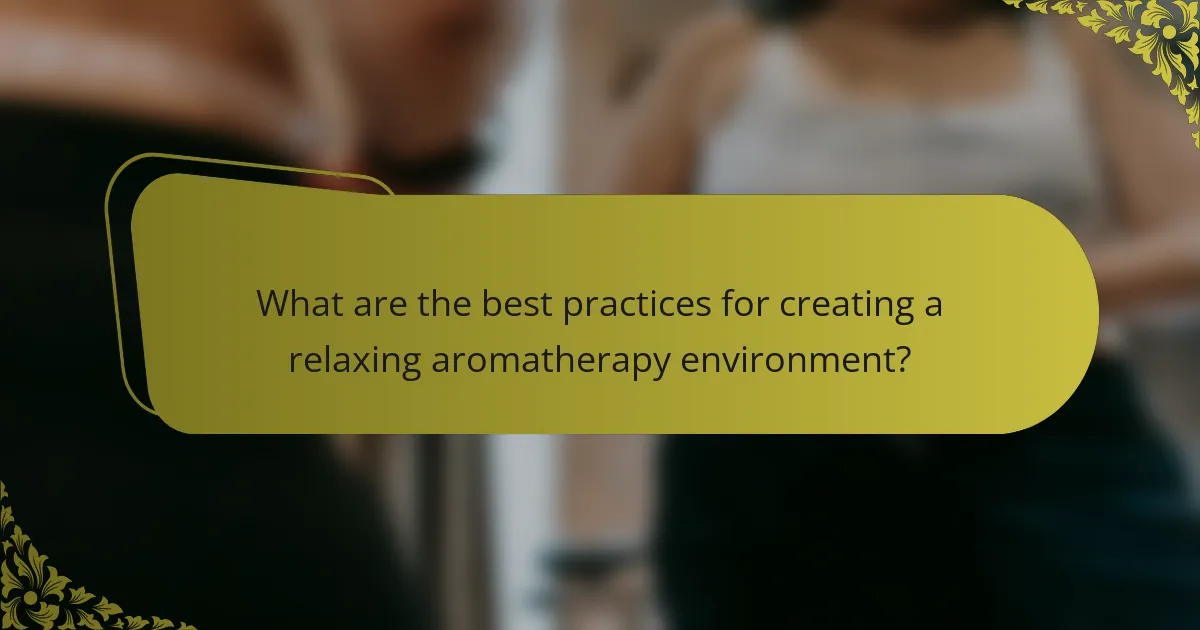
What are the best practices for creating a relaxing aromatherapy environment?
To create a relaxing aromatherapy environment, focus on specific practices that enhance the experience. Start by selecting calming essential oils like lavender, chamomile, or sandalwood. Use a diffuser to disperse the aroma evenly throughout the space. Ensure the room is dimly lit, as soft lighting contributes to relaxation. Incorporate soothing sounds, such as gentle music or nature sounds, to further enhance the ambiance. Lastly, maintain a comfortable temperature and consider adding elements like soft cushions or blankets to create a cozy atmosphere.
How can lighting and ambiance enhance the effects of aromatherapy?
Lighting and ambiance significantly enhance the effects of aromatherapy by creating a conducive environment for relaxation and mood enhancement. Soft, warm lighting can promote feelings of calmness, while dim lighting reduces distractions and fosters tranquility.
The use of coloured lights can also influence emotional responses; for instance, blue light is known to aid in relaxation, while yellow light can elevate mood. Complementing aromatherapy with soothing sounds and gentle decor further enriches the sensory experience, promoting deeper relaxation and improved emotional well-being.
By aligning the ambiance with the chosen essential oils, users can maximize the therapeutic benefits. For example, lavender oil paired with soft, warm lighting can enhance sleep quality, while citrus scents in a bright, cheerful environment can uplift spirits.
Which tools and diffusers are recommended for optimal use?
For optimal use of aromatherapy, recommended tools include ultrasonic diffusers, nebulizing diffusers, and essential oil rollers. Each tool enhances relaxation and mood through effective oil dispersion.
| Tool Type | Description | Benefits |
|———————-|———————————————|———————————|
| Ultrasonic Diffuser | Uses water and ultrasonic waves to disperse essential oils | Creates a fine mist, humidifies air |
| Nebulizing Diffuser | Directly vaporizes essential oils without water | Intense aroma, no dilution |
| Essential Oil Roller | Combines oils in a portable roller bottle | Convenient application, targeted use |

What unique blends can be created for specific moods or situations?
Unique blends for specific moods or situations can enhance relaxation and mood. For stress relief, combine lavender, chamomile, and bergamot. For energy boost, use peppermint, lemon, and eucalyptus. To promote focus, blend rosemary, basil, and cedarwood. For sleep, mix sandalwood, ylang-ylang, and vetiver. Each combination targets distinct emotional states effectively.
How do personal preferences influence the effectiveness of essential oil blends?
Personal preferences significantly impact the effectiveness of essential oil blends in aromatherapy. Individual responses to scents vary, influencing relaxation and mood enhancement outcomes. For example, one person may find lavender calming, while another prefers citrus for upliftment. Additionally, unique attributes like scent memory and emotional associations can enhance or detract from the experience. Personalization of blends based on these preferences leads to more effective aromatherapy sessions.
What rare essential oils are known for their unique calming properties?
Rare essential oils known for unique calming properties include blue chamomile, helichrysum, and spikenard. Blue chamomile offers anti-inflammatory benefits, while helichrysum is recognized for its emotional healing effects. Spikenard is prized for deep relaxation and stress relief. These oils enhance aromatherapy practices, providing distinct emotional support.
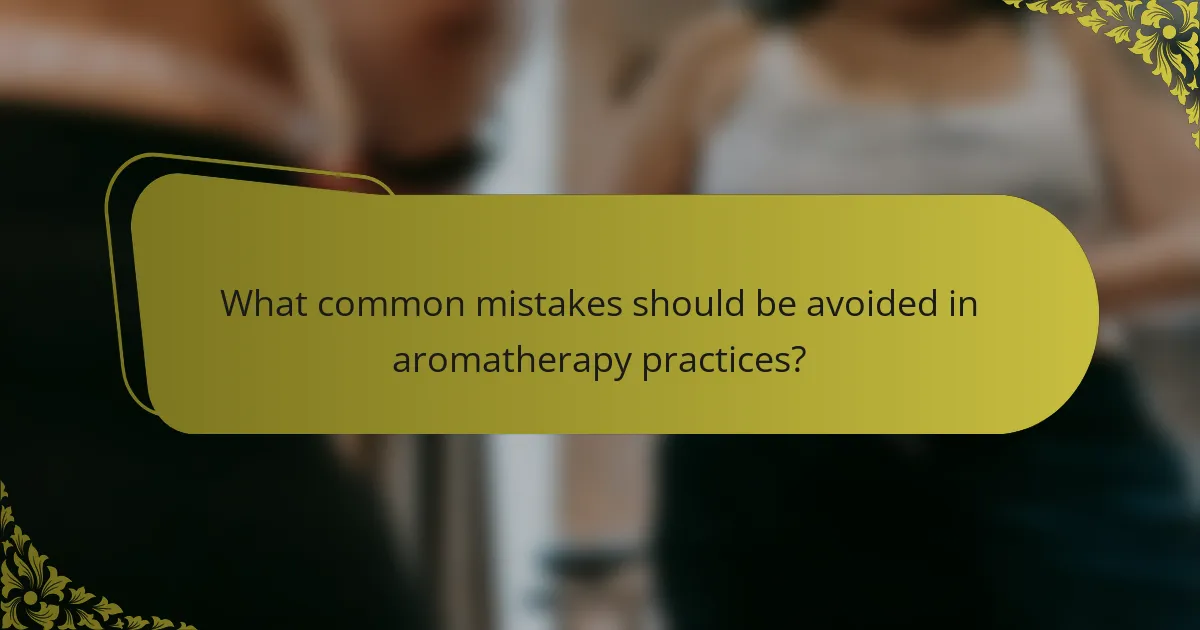
What common mistakes should be avoided in aromatherapy practices?
Avoiding common mistakes in aromatherapy enhances relaxation and mood benefits. Key errors include using low-quality essential oils, neglecting proper dilution, and overlooking individual sensitivities. Many practitioners fail to research oil properties, leading to ineffective or adverse effects. Additionally, not considering the environment can diminish the therapeutic experience.
How can overuse of essential oils lead to adverse effects?
Overuse of essential oils can lead to adverse effects such as skin irritation, respiratory issues, and headaches. High concentrations may overwhelm the body, causing toxicity. Essential oils, while beneficial for relaxation, should be used in moderation to avoid these negative outcomes. Users should always dilute oils and consult guidelines for safe usage.
What are the signs of allergic reactions to essential oils?
Signs of allergic reactions to essential oils include skin irritation, respiratory issues, headaches, nausea, and swelling. These symptoms may vary in severity and can occur shortly after exposure. Monitoring for these reactions is crucial for safe aromatherapy use. If any signs appear, discontinue use immediately and consult a healthcare professional.
Which safety guidelines should be followed when using essential oils?
When using essential oils, follow safety guidelines to ensure effective and safe aromatherapy. Always dilute essential oils before topical application to prevent skin irritation. Conduct a patch test to check for allergic reactions. Avoid ingestion unless guided by a qualified professional. Keep essential oils out of reach of children and pets. Use oils in well-ventilated areas to prevent respiratory issues. Pregnant or nursing individuals should consult a healthcare provider before use.

How can aromatherapy be integrated into daily routines for lasting benefits?
Aromatherapy can be seamlessly integrated into daily routines through simple practices that enhance relaxation and mood. Start by incorporating essential oils into your morning routine, such as diffusing citrus oils to uplift your spirits.
Consider using lavender oil during evening rituals to promote calmness before sleep. Applying essential oils topically, such as peppermint for mental clarity during work hours, can also be effective.
Creating a dedicated space for aromatherapy, like a cozy corner with a diffuser, encourages regular use. Lastly, explore blending oils to customize scents that resonate with your mood and preferences, ensuring lasting benefits.
What are effective ways to incorporate aromatherapy into workspaces?
Incorporating aromatherapy into workspaces can enhance relaxation and improve mood. Use essential oil diffusers to disperse calming scents like lavender or citrus. Create a designated relaxation area with comfortable seating and soothing aromas. Encourage short breaks for employees to engage in mindfulness practices while enjoying aromatherapy. Consider using scented candles or personal inhalers to allow individual scent preferences.
How can mindfulness practices enhance the benefits of aromatherapy?
Mindfulness practices significantly enhance the benefits of aromatherapy by promoting deeper relaxation and emotional balance. When combined, these techniques amplify the calming effects of essential oils, leading to improved mood and reduced stress. Mindfulness encourages present-moment awareness, which helps individuals fully experience the therapeutic properties of aromas. Studies indicate that integrating mindfulness with aromatherapy can enhance psychological well-being, making it a powerful duo for stress relief.
What expert tips can optimize the use of aromatherapy for relaxation?
To optimize aromatherapy for relaxation, consider these expert tips. Choose essential oils known for their calming properties, such as lavender or chamomile. Use a diffuser to evenly distribute scents in your space. Create a serene environment by incorporating soft lighting and comfortable seating. Establish a routine by practicing aromatherapy at the same time daily to reinforce relaxation. Lastly, combine aromatherapy with mindfulness techniques like deep breathing for enhanced effects.
